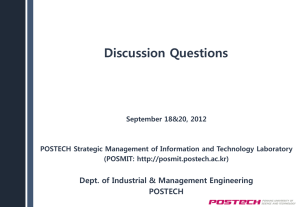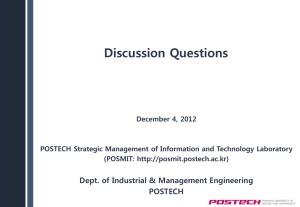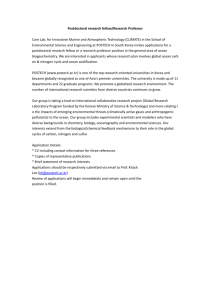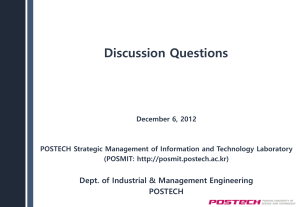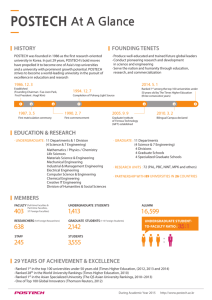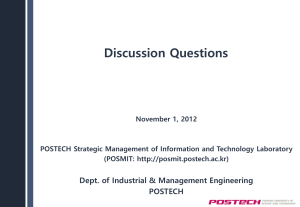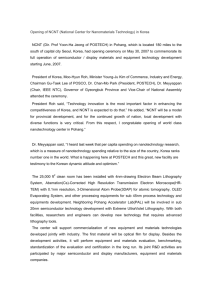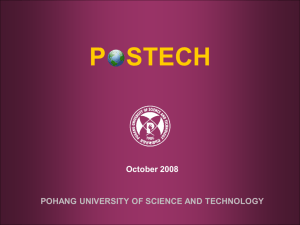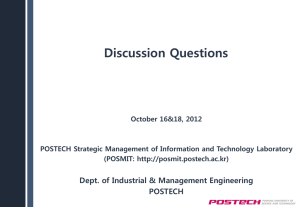postech - nesap-ict
advertisement
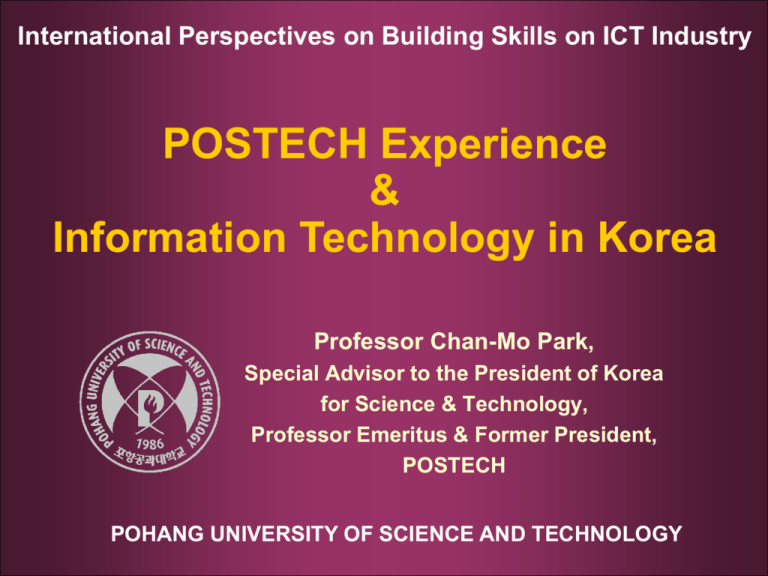
International Perspectives on Building Skills on ICT Industry POSTECH Experience & Information Technology in Korea Professor Chan-Mo Park, Special Advisor to the President of Korea for Science & Technology, Professor Emeritus & Former President, POSTECH POHANG UNIVERSITY OF SCIENCE AND TECHNOLOGY POSTECH OVERVIEW THINKING OF SCIENCE, THE NATION AND THE FUTURE 1/59 POHANG UNIVERSITY OF SCIENCE AND TECHNOLOGY Location of POSTECH POSTECH Overview Located in Pohang on the southeastern coast of Korea Pohang is also home of POSCO (1) POSTECH Korea POSCO Seoul 350Km Pohang (1) POSCO: Pohang Iron & Steel Company THINKING OF SCIENCE, THE NATION AND THE FUTURE 2/59 POHANG UNIVERSITY OF SCIENCE AND TECHNOLOGY Campus POSTECH Overview Pohang Technopark PAL(1) Land: 1,731,759m² Student Dormitory and Apartments Faculty Apartment Building: 423,758m² Student: 3,046 POSCO International Center Tae-Joon Park Digital Library PBC(4) 1,310 (undergraduate) 1,736 (graduate) Faculty: 242 Researcher: 785 Biotech Center PIRO(3) Main Campus RIST(2) (Post-doctoral: 170) Staff: 234 Regular: 206 Others: 28 RIST (2) (As of October 2008) (1) PAL: Pohang Accelerator Laboratory (2) RIST: Research Institute of Industrial Science and Technology (3) PIRO: Pohang Institute of Intelligent Robotics (4) PBC: POSTECH Biotechnology Center THINKING OF SCIENCE, THE NATION AND THE FUTURE 3/59 POHANG UNIVERSITY OF SCIENCE AND TECHNOLOGY Founding Philosophy POSTECH Overview Providing the best education for future world leaders Performing cutting-edge research in science and engineering Serving the nation & contributing to the world’s scientific community THINKING OF SCIENCE, THE NATION AND THE FUTURE 4/59 POHANG UNIVERSITY OF SCIENCE AND TECHNOLOGY Chronology 1986 1992 POSTECH Overview • Pohang Institute of Science and Technology open as the first research-oriented university in Korea • Graduate School of Information Technology (GSIT) open 1994 • Pohang Accelerator Laboratory, PAL (3rd-generation accelerator: 2 GeV), open • Change of official name to Pohang University of Science and Technology 1995 • Graduate School of Iron & Steel Technology (GSIST) open 1996 • School of Environmental Science and Engineering (SEE) open 1998 • Asiaweek Magazine (1) ranks POSTECH #1 among Asian science & technology univ. 2001 • Asia Pacific Center for Theoretical Physics (APCTP) headquarters moves to POSTECH 2002 • JoongAng Daily (2) ranks POSTECH #1 among Korean universities • Ministry of Education & Human Resources selects POSTECH as ‘Excellent university for educational reform’ (7 years in a row) 2003 • POSTECH Biotech Center, PBC, open • JoongAng Daily ranks POSTECH #1 among Korean universities • Tae-Joon Park Digital Library open 2005 • JoongAng Daily ranks POSTECH #1 among Korean universities (4 years in a row) 2006 • POSTECH Vision 2020 Declaration Ceremony 2007 • JoongAng Daily ranks POSTECH #1 among Korean universities • The Times Higher Education Supplement (3) ranks POSTECH #11 in Citations per Faculty (1) Published in Hong Kong (2) Major Korean daily newspaper (3) Published in United Kingdom THINKING OF SCIENCE, THE NATION AND THE FUTURE 5/59 POHANG UNIVERSITY OF SCIENCE AND TECHNOLOGY POSTECH VISION 2020 VISION POSTECH Overview World’s top 20 by 2020 Foster talent in S&T OBJECTIVE (creative, progressive, global leaders) Create research breakthroughs (strong academic & social impact) Selection & Concentration Interdisciplinary Programs Globalization Process Innovation STRATEGY 3. Faculty 1. Education 4. Globalization 2. Research 5. Finances Founding principles THINKING OF SCIENCE, THE NATION AND THE FUTURE 6/59 POHANG UNIVERSITY OF SCIENCE AND TECHNOLOGY POSTECH VISION 2020 POSTECH Overview 5 Key Areas, 24 Action Plans STRATEGY Education Creative, progressive, and global leaders Research-oriented / Project-based Global leadership + business savvy Need-based / customized Research Strong academic and social impact R&BD Strong impact (Cell, Nature, Science) Interdisciplinary convergent programs World Top Class Tenure evaluation Performance review & merit system Global Visibility Global brand image Expand lectures in English & int’l faculty Infrastructures Faculty Globalization Finances Increase and Diversify THINKING OF SCIENCE, THE NATION AND THE FUTURE 24 ACTION PLANS OBJECTIVE Increase proportion of O/H income Intellectual property rights Fund-raising 7/59 POHANG UNIVERSITY OF SCIENCE AND TECHNOLOGY Academic Programs POSTECH Overview • 10 undergraduate departments, 14 graduate programs • Faculty to undergraduate student ratio: 1 to 6 • 300 freshmen admitted per year representing top 1% of high school graduates Undergraduate Chemistry Life Science Mathematics Physics Chemical Eng. Computer Science & Eng. Electronic & Electrical Eng. Industrial & Management Eng. Materials Science & Eng. Mechanical Eng. (Division of Humanities & Social Sciences) THINKING OF SCIENCE, THE NATION AND THE FUTURE Graduate Chemistry Molecular & Life Sciences Mathematics Physics Chemical Eng. Electrical & Computer Eng. Materials Science & Eng. Mechanical & Industrial Eng. School of Interdisciplinary Biosci. & Bioeng. School of Environmental Science & Eng. Graduate School for Information Tech. Graduate School for Wind Energy Graduate Institute of Ferrous Technology Graduate Program for Technology Innovation & Management 8/59 POHANG UNIVERSITY OF SCIENCE AND TECHNOLOGY Post-Graduate Careers POSTECH Overview Employment rate for 2007 graduates Enter Graduate School Degree Graduates POSTECH Others Employment Military Service B.S. 306 (100%) 148 (48.3%) 50 (16.4%) 97 (31.7%) 11 (3.6%) M.S. 174 (100%) 46 (26.4%) 12 (6.9%) 111 (63.8%) 5 (2.9%) Ph.D. 120 (100%) - - 120 (100%) - Total THINKING OF SCIENCE, THE NATION AND THE FUTURE 600 9/59 POHANG UNIVERSITY OF SCIENCE AND TECHNOLOGY National Ranking POSTECH Overview JoongAng Daily Overall Rankings (1996~2008) Year/Rank #1 #2 #3 2008 Korea Advanced Institute of Science and Technology (KAIST) Pohang University of Science and Technology (POSTECH) Seoul National University (SNU) 2007 POSTECH KAIST SNU 2006 KAIST 2005 POSTECH KAIST SNU 2004 POSTECH KAIST SNU 2003 POSTECH KAIST SNU 2002 POSTECH KAIST SNU 2001 KAIST POSTECH SNU 2000 KAIST POSTECH SNU 1999 KAIST POSTECH SNU 1998 KAIST POSTECH SNU 1997 POSTECH KAIST SNU 1996 POSTECH KAIST SNU THINKING OF SCIENCE, THE NATION AND THE FUTURE POSTECH, SNU 10/59 POHANG UNIVERSITY OF SCIENCE AND TECHNOLOGY International Ranking POSTECH Overview The Times Higher Education Supplement 2008 Overall Ranking of POSTECH : 188 Criteria Peer Review Employer Int’l Faculty Int’l Student Faculty/ Student Citations/ Faculty Overall Score (Rank) Weighting of Item 40% 10% 5% 5% 20% 20% - Seoul National Univ. 97 (33) 65 23 37 87 (58) 54 78.1 (50) KAIST 76 (110) 53 (239) 48 36 61 79 (69) 69.3 (95) POSTECH 37 (334) 34 (368) 52 19 67 99 (17) 56.1 (188) THINKING OF SCIENCE, THE NATION AND THE FUTURE 11/59 POHANG UNIVERSITY OF SCIENCE AND TECHNOLOGY International Ranking POSTECH Overview The Times Higher Education Supplement 2008 World Top 20 – Citations per Faculty 1 CALIFORNIA Institute of Technology (Caltech) United States 100 2 STANFORD University United States 100 3 MASSACHUSETTS Institute of Technology (MIT) United States 100 4 University of CALIFORNIA, Berkeley United States 100 5 HARVARD University United States 100 6 PRINCETON University United States 100 7 University of CALIFORNIA, San Diego United States 100 8 University of TORONTO Canada 100 9 University of CALIFORNIA, Los Angeles United States 100 10 JOHNS HOPKINS University United States 100 11 ETH Zurich Switzerland 99 12 BROWN University United States 99 13 Ecole Normale Superieure, PARIS France 99 14 University of PENNSYLVANIA United States 99 15 GWANGJU Institute of Science and Technology Korea, South 99 16 University of WASHINGTON United States 99 17 POHANG UNIVERSITY OF SCIENCE AND TECHNOLOGY Korea, South 99 18 University of ZURICH Switzerland 99 19 GEROGIA Institute of Technology United States 99 20 University of CALIFORNIA, Santa Barbara United States 99 THINKING OF SCIENCE, THE NATION AND THE FUTURE 12/59 POHANG UNIVERSITY OF SCIENCE AND TECHNOLOGY Financial Data POSTECH Overview Fiscal year 2007 Operating Expenditures (in USD millions): $261.1M Income Government $12.8M (5%) Others $17.9M (7%) Endowments $103.9M (40.9%) THINKING OF SCIENCE, THE NATION AND THE FUTURE Expenditure Tuition $16.6M (6.5%) Others $21.9M (8.4%) Research Projects $103.2M (40.6%) Operating Activities $19M (7.3%) Salaries & Benefits $42M (16.1%) Student Costs and Aid $12.4M (4.7%) Research Funds $94.5M (36.2%) Fixed Assets $71.3M (27.3%) 13/59 POHANG UNIVERSITY OF SCIENCE AND TECHNOLOGY Financial Data POSTECH Overview Combined fiscal years 1985 ~ 2007 (in USD millions) Income $3,025.5M Others $153.6M (5%) Tuition $188.7M (6%) Government $428.1M (14%) POSCO $464.8M (16%) Expenditure $2,976.5M Fixed Assets $334.9M (11%) Research Projects $1,029.2M (34%) 1 2 3 4 5 6 Endowments $761.1M (25%) THINKING OF SCIENCE, THE NATION AND THE FUTURE 14/59 Operating Activities $468.1M (16%) Student Costs and Aid $145.6M (5%) Research Funds $911.3M (31%) Salaries & Construction Benefits $595.5M $521.1M (20%) (17%) POHANG UNIVERSITY OF SCIENCE AND TECHNOLOGY International Network POSTECH Overview 73 sister universities in 19 countries across the world Australia (4) The Australian National U U of Melbourne U of Newcastle U of New South Wales Austria (1) Technische Universität Graz Canada (1) U of Waterloo China (13) Fudan U Harbin Institute of Technology Nanjing U Northeastern U Peking U Shanghai Jiao Tong U Tsinghua U U of Electronic Science & Technology of China U of Science & Technology Beijing U of Science & Technology of China Xian Jiaotong U Yanbian U of Science & Technology Zhejiang U Denmark (1) Technical U of Denmark France (10) École Centrale de Nantes École Nationale Supérieure des Mines de Paris Institut National Polytechnique de Grenoble Institut National Polytechnique de Toulouse Université de Technologie de Compiègne Université de Technologie de Belfort-Montbéliard Université de Technologie de Troyes Institut National des Sciences Appliquées de Lyon (INSA-Lyon) École Nationale Supérieure d’ingénieurs de Caen École Polytechnique Germany (5) Freie Universität Berlin Max Planck Gesellschaft RWTH Aachen Technische Universität Berlin Technische Universität Kaiserslautern Italy (1) Politechnico di Torino Japan (6) Kyoto U Kyushu U Ritsumeikan U Ritsumeikan Asia Pacific U Tohoku U Tokyo Institute of Technology Democratic People’s Republic of Korea (1) New Zealand (1) Pyongyang U of Science and Technology U of Auckland Russia (5) Moscow Engineering Physics Institute Moscow State U St. Petersburg Electrotechnical U The Joint Institute of Nuclear Research St. Petersburg State Polytechnical U THINKING OF SCIENCE, THE NATION AND THE FUTURE 15/59 Slovakia (1) Slovak U of Technology in Bratislava Switzerland (1) Eidgenössische Technische Hochschule Zürich Thailand (1) Suranaree U of Technology Taiwan (3) National Cheng Kung U National Tsing Hua U National Taiwan U United Kingdom (2) Imperial College of Science, Technology & Medicine U of Birmingham United States (12) Carnegie Mellon U U of California, Berkeley U of California, Davis U of California, Merced U of Maryland, College Park U of Minnesota, Twin Cities California Institute of Technology U of Illinois at Urbana-Champaign Princeton Plasma Physics Laboratory Rensselaer Polytechnic University Syracuse U U of Washington, Seattle Vietnam (4) Hanoi U of Technology Vietnam National U, Hanoi Vietnam National U, Ho Chi Minh Vietnamese Academy of Science and Technology POHANG UNIVERSITY OF SCIENCE AND TECHNOLOGY Global Leadership Programs POSTECH Overview Exchange & study abroad Internship Summer sessions ESL programs Cross Strait Symposium AEARU Student Camp Bang Doshie Global Expedition Study Tour for Student Leaders THINKING OF SCIENCE, THE NATION AND THE FUTURE 16/59 POHANG UNIVERSITY OF SCIENCE AND TECHNOLOGY World-renowned Scholars Lecture Program POSTECH Overview Fields medalists, Nobel Laureates and world-renowned scholars Lectures, discussions, workshops Year Area 1991 Physics 1992 Lecturer Position / Prize Norman F. Ramsey Harvard U / 1989 Nobel Prize (Physics) Chemistry Derek Barton Texas A&M Univ. / 1969 Nobel Prize (Chemistry) 1994 Life Science Bert Sakmann Heidelberg U / 1991 Nobel Prize (Medical Science) 1995 Mathematics John Milnor New York State U / 1962 Fields Medal 1997 Physics Ilya Prigogine Prigogine Center / 1977 Nobel Prize (Chemistry) 1999 Chemistry Jean Marie Lehn U of Louis Pasteur / 1987 Nobel Prize (Chemistry) 2001 Mathematics Efim I. Zelmanov Yale U / 1994 Fields Medal 2001 Political Science R. Scalapino UC Berkeley 2002 Life Science Paul Greengard The Rockefeller U / 2000 Nobel Prize (Physiology) 2004 Physics Robert B. Laughlin Stanford U / 1998 Nobel Prize (Physics) - POSTECH Chair-Professor 2006 Mathematics Jean-Christophe Yoccoz College de France / 1994 Fields Medal 2006 Chemistry Roderick MacKinnon Rockefeller U / 2003 Nobel Prize (Chemistry) 2007 Life Science Peter C. Doherty U of Melbourne / 1996 Nobel Prize (Physiology or Medicine) THINKING OF SCIENCE, THE NATION AND THE FUTURE 17/59 POHANG UNIVERSITY OF SCIENCE AND TECHNOLOGY Bilingual Campus POSTECH Overview Lectures in English and international faculty Program 2006 2007 2010 2020 Lectures in English (Under/Graduate) 16.8/33.5% 22.3/49.5% 50/100% 100/100% International Faculty 7.5% 8.9% 15% 20% POSTECH English Certification System (undergraduate) Must complete highest level to graduate Efficient way of better advancing English skills Unique system fit for individual needs Placement into 5 Levels Focused on speaking and writing Implemented in March 2008 Korean-English bilingual campus Online POVIS (POSTECH Vision Information System) POSTECH website Offline Text books PR materials, official documents, Signboards and placards Administrators’ English Proficiency THINKING OF SCIENCE, THE NATION AND THE FUTURE Promotion Language training and experience Language Education Center 18/59 POHANG UNIVERSITY OF SCIENCE AND TECHNOLOGY Research Publications POSTECH Overview (Year) Total SCI Year 1998 1999 2000 2001 2002 2003 2004 2005 2006 2007 Total 1,180 1,257 1,310 1,176 1,219 1,250 1,466 1,203 1,259 1,328 SCI SCI 566 586 585 732 790 964 1,069 939 1,103 1,053 2.9 2.9 2.9 3.5 3.8 4.7 5.2 4.4 5.0 4.6 2.17 2.21 2.17 2.15 2.23 2.40 2.54 (per Faculty) Impact Factor THINKING OF SCIENCE, THE NATION AND THE FUTURE 19/59 POHANG UNIVERSITY OF SCIENCE AND TECHNOLOGY Research Grants by Sponsor POSTECH Overview (Unit: 1,000 USD) (Year) POSTECH POSCO Government Industry Others Year 1998 1999 2000 2001 2002 2003 2004 2005 2006 2007 POSTECH 1,027 1,864 1,723 4,081 2,942 2,210 4,120 2,387 5,436 6,300 POSCO Government Industry Others 7,524 24,628 2,331 1,114 12,364 32,226 2,246 829 27,945 32,413 6,128 389 27,110 37,987 3,522 351 13,277 43,202 4,957 835 14,532 45,142 3,887 1,225 19,621 71,148 5,757 1,094 21,245 67,119 6,243 816 27,032 75,665 6,003 1,191 30,316 79,091 7,921 219 Total 36,624 49,529 68,598 73,051 65,213 66,996 101,740 97,810 115,327 123,847 THINKING OF SCIENCE, THE NATION AND THE FUTURE 20/59 POHANG UNIVERSITY OF SCIENCE AND TECHNOLOGY Academy-Industry Cooperation POSTECH Overview Large Corporations (Samsung, LG, Hyundai, etc.) IT, BT, NT Fusion Technology • Leading Technology Development • High Tech Skills Training • WCU (IT, BT, MT), BK21 POSCO Ferrous Technology • EXXON MOBIL - POSCO - RIST linked Industry-Academy-Research Cooperation • Graduate Institute of Ferrous Technology (GIFT) – Nurture Human Resources THINKING OF SCIENCE, THE NATION AND THE FUTURE Industry – Univ. Cooperation Foundation & Core Research Centers • National Center for Nanomaterials Technology (NCNT) • Pohang Accelerator Laboratory (PAL) • Pohang Institute of Intelligent Robotics (PIRO) • POSTECH Biotech Center (PBC) 21/59 Smaller Businesses Applicable Technology • Readily Applicable Technology Development • Government Support POHANG UNIVERSITY OF SCIENCE AND TECHNOLOGY Int’l Joint Research POSTECH Overview International Cooperation System Establishment Cutting-edge Research (IT, BT, NT, ET) aimed for the Global Market Practice Global Competitive Power & Build National Research Infrastructure Joint Research with International Research-Oriented Universities Academy-Industry Cooperation with International Companies Contribution to the Nation’s Development Recent Joint Research Projects with International Institutions Year Project No. Fund 1999 5 0.82M Norvatis, Chiron, AFOSR, Elkem 2000 5 0.37M GE, NRL, GM, Elkem 2001 5 0.21M Oriol, GM, IBM, NRL 2002 3 0.45M GM, AFOSR 2003 6 0.23M AOARD, Stanford University, JST 2004 11 0.58M AFOSR, JST, STREM, FISC 2005 8 0.27M AFOSR, AOARD, ASAHI, LAM 2006 14 0.99M MS, GM, AOARD, NARSAD, JST 2007 7 0.34M MS, GM, NARSAD, SEMATECH THINKING OF SCIENCE, THE NATION AND THE FUTURE Foreign Institutions 22/59 POHANG UNIVERSITY OF SCIENCE AND TECHNOLOGY Core Research Areas ET NT BT IT & ICT POSTECH Overview (Environmental Tech) (Nano Tech) (Bio Tech) Computer Science & Engineering Electronic & Electrical Engineering • Multimedia Interface • Computer Network • System and Software • Comm. & Signal • IC & VLSI Design • Control & Power Electronics GSIT & PIRL Graduate School for IT Convergence Eng • Communications • ASIC & Systems • Software THINKING OF SCIENCE, THE NATION AND THE FUTURE • Korea’s WCU project • Ubiquitous Autonomic System 23/59 POHANG UNIVERSITY OF SCIENCE AND TECHNOLOGY Computer Science and Engineering POSTECH Overview Multimedia Interface Computer Graphics Lab. Computer Vision Lab. Intelligent Multimedia Lab. Intelligent Software Lab. Knowledge & Language Engineering Lab. Virtual Reality Lab. Faculty: 19 Research Professors: 2 Undergraduate Students: 149 Graduate Students: 132 2007 SCI Publications: 43 2007 Research Grants: USD 5.7M Computer Network Distributed Processing & Network Management Lab. Mobile Networking Lab. Multimedia Communication System Lab. Networking & Distributed Systems Lab. System and Software High Performance Computing Lab. Software Engineering Lab. System Software Lab. Information and Database Systems Lab. Programming Languages Lab. THINKING OF SCIENCE, THE NATION AND THE FUTURE 24/59 POHANG UNIVERSITY OF SCIENCE AND TECHNOLOGY Electrical and Electronic Engineering Communications & Signal Research Faculty: 32 Research Professors: 5 Undergraduate students: 215 Graduate students: 283 2007 SCI Publications: 105 2007 Research Grants: USD 15M THINKING OF SCIENCE, THE NATION AND THE FUTURE POSTECH Overview Electromagnetics & Microwave Eng. Communications & Signal Processing Coding and Communications Lab. Information Security & Telecommunication Lab. Communications Research Lab. Communication Systems and Circuit Lab. Communication & Information Systems Lab. Computer Engineering Computer Architecture Lab. Intelligent Robotics Lab. Intelligent Signal Processing Lab. Image Information Processing Lab. Control and Power Electronics System and Networking Lab. Intelligent Control and Systems Lab. Control Lab. Advanced Control Systems Lab. Robotics & Automation Lab. Energy-Circuit Lab. 25/59 Microwave Systems Lab. EM Wave Propagation Lab. Antenna Lab. Electromagnetics Lab. Solid State & Quantum Electronics Plasma Application Unit Processing & Simulation for Semiconductor Tech Quantum Photonics Lab. Monolithic Microwave Integrated Circuit Lab. Advanced Nano Device Lab. Plasma Application Modeling Group Nanodevices & Circuit Lab. Center for Terahertz Photonics Integrated Circuits & VLSI Design Analog Systems Lab. IC Lab. CAD & SoC Design Lab. High Performance Computer Lab. POHANG UNIVERSITY OF SCIENCE AND TECHNOLOGY GSIT & PIRL POSTECH Overview Graduate School of Information Technology POSTECH Information Research Laboratories Communications Area Coding & Communications Communication Research Communication Signal Processing Communication Systems and Circuits Electromagnetic Technology Lab Antenna Lab Electromagnetic Technology Lab. Faculty: 44 Researchers: 18 Graduate Students: 55 2008 Research Grants: USD 2.6M THINKING OF SCIENCE, THE NATION AND THE FUTURE ASIC & Systems Area Applied Networking Technology Lab Control & Motor Drive Lab Computer Architecture Lab Monolithic Microwave & integrated Circuits VLSI & CAD Lab Robotics Automation Lab VLSI Systems Lab Power electronics Lab Multimedia signal Process Lab Quantum Photonics Lab High Speed CMOS IC Lab Radar system Lab Nanodevice & Circuit Lab 26/59 Software Area Advanced Network & Mobile Computing Computer Graphics Distributed Processing & Network Management High Performance Computer Natural Language Processing Intelligent Information Systems Information Security & Telecom. Image Information Processing Network & Distributed Systems Knowledge & Language Eng Neural Computing Group Pattern Recognition System Software Software Engineering Virtual Reality Application S/W Area Data Knowledge Engineering Lab POSTECH Statistical Consulting Lab POSTECH Strategic Management of Information Systems Lab POHANG UNIVERSITY OF SCIENCE AND TECHNOLOGY GSITCE POSTECH Overview Graduate School for IT Convergence Engineering (1) Catholic U of Korea College of Medicine POSCO U-Health U-Environment Autonomics for IT Convergence NCNT Nano sensor/ system Nano deivce Nano Technology Bio Informatics Near field comm. Age disease Ultra low power analysis wireless comm. Bio Technology Motorola NASA U of Waterloo U of Evry CSU McMaster U TU Dresden UCSF Communication Network POSTECH Graduate School for IT Convergence Engineering (1) Supported by “World Class University” project with classes opening September 2009 THINKING OF SCIENCE, THE NATION AND THE FUTURE 27/59 POHANG UNIVERSITY OF SCIENCE AND TECHNOLOGY TJP Library & PBC POSTECH Overview Tae-Joon Park Digital Library • Digitalization/internet DB construction of academic information • Information hub with cyber function • Providing an environment for various multimedia utilization POSTECH Biotechnology Center (PBC) • Cutting-edge research and education in biotechnology, academia-industry cooperation • Major research areas: molecular medicine, plant biotechnology, nanobiotechnology, basic sciences & technology THINKING OF SCIENCE, THE NATION AND THE FUTURE 28/59 POHANG UNIVERSITY OF SCIENCE AND TECHNOLOGY NCNT & PIRO POSTECH Overview National Center for Nanomaterials Technology (NCNT) • Support nanomaterials industrialization • Establish academy-industry cooperation • Train manpower in the field of nanomaterials Pohang Institute of Intelligent Robotics (PIRO) • Service robot: moving platform, operating, intelligence technology • Bio-medical robot: cell operating, haptic medical robot, diagnosis robot • Ocean floor robot: probing, picking minerals THINKING OF SCIENCE, THE NATION AND THE FUTURE 29/59 POHANG UNIVERSITY OF SCIENCE AND TECHNOLOGY PAL POSTECH Overview Pohang Accelerator Laboratory (PAL) Storage Ring Linear Accelerator Administration building Linear accelerator 160m long, 2.5 GeV Storage ring 2.5 GeV, 12-period Triple Bend Achromat lattice, low emittance third generation machine, 280m in circumference Beamlines Operating 23 beamlines Users More than 1,000 per year THINKING OF SCIENCE, THE NATION AND THE FUTURE 30/59 POHANG UNIVERSITY OF SCIENCE AND TECHNOLOGY POSCO International Center POSTECH Overview 17,032 m2 Conference Halls Hotel & dining facilities THINKING OF SCIENCE, THE NATION AND THE FUTURE 31/59 POHANG UNIVERSITY OF SCIENCE AND TECHNOLOGY What Makes POSTECH Successful? POSTECH Overview 1 The best research-oriented university in Korea 2 Small in size but excellent in quality 3 Low faculty to student ratio 4 Highest education investment in Korea 5 Scholarships/assistantships for all students 6 Lodging provided for all academic members 7 Outstanding faculty 8 World-class research achievement 9 Active academy-industry cooperation 10 Strong community support THINKING OF SCIENCE, THE NATION AND THE FUTURE 32/59 POHANG UNIVERSITY OF SCIENCE AND TECHNOLOGY POSTECH Vision Accomplishment POSTECH Overview World-class Research-oriented University World’s Top 20 by 2020 Best 10 research accomplishments by the year 2010 2006 New Leap (20th Anniversary) Selection & Concentration Interdisciplinary Programs THINKING OF SCIENCE, THE NATION AND THE FUTURE 33/59 Globalization Process Innovation POHANG UNIVERSITY OF SCIENCE AND TECHNOLOGY ICT EDUCATION in AFRICA THINKING OF SCIENCE, THE NATION AND THE FUTURE 34/59 POHANG UNIVERSITY OF SCIENCE AND TECHNOLOGY Africa Today ICT Education in Africa • Population: 922,011,000 (2005) • 54 Countries • Official Language English: 19 Countries / French: 21 Countries • Over 130 Universities • 3 Million Students (1) in S.S. Africa (2) • Increase in # of Student in S.S. Africa: 15% per year (3) • Average of Student Enrollment: 5% of total population • World Bank assists shaping and defining the policies • Establishment of National and international regulatory frameworks for higher education (1) World Development Indicators Database, World Bank, 2004 (2) Sub Saharan Africa (3) University Leader’s Forum, World Bank 2006 THINKING OF SCIENCE, THE NATION AND THE FUTURE 35/59 POHANG UNIVERSITY OF SCIENCE AND TECHNOLOGY IT & ICT Opportunities • • • • • • • • • ICT Education in Africa Potential to create new opportunities Key enabler of globalization Accelerate a dynamic of social & economic development Extremely cost-effective Need for strategic partnerships: local, civic, and global levels Government support necessary: budget allocation Foreign investors seek for ICT prospects of Africa ICT venture companies close to Universities University graduates or returnees from abroad with IT & ICT related ideas should be targeted THINKING OF SCIENCE, THE NATION AND THE FUTURE 36/59 POHANG UNIVERSITY OF SCIENCE AND TECHNOLOGY Next-Generation Technology University ICT Education in Africa VISION Better Africa NETWORK University IT Industry FACULTY WorldNEXT-GENERATION renowned TECHNOLOGY UNIVERSITY TALENT Potential & Diversity THINKING OF SCIENCE, THE NATION AND THE FUTURE FUND Government Industry 37/59 POHANG UNIVERSITY OF SCIENCE AND TECHNOLOGY Next-Generation Technology University ICT Education in Africa • Foster next-generation African leaders VISION • Add to advancement of nation and Africa • Contribute to the future of science & technology • Significant synergies from collaborations NETWORK • Joint research projects with foreign universities • Concentration on IT related partnerships • Avoid standardization, look for potential & diversity TALENT • Distinctive programs & features • Specific image & qualifications of ideal students • Invite world-renowned scholars FACULTY • Attract graduates of world’s top institutes • Superb research infrastructure FUND • Government investment • Academy-Industry cooperation • Work with community-based organizations THINKING OF SCIENCE, THE NATION AND THE FUTURE 38/59 POHANG UNIVERSITY OF SCIENCE AND TECHNOLOGY POSTECH & AFRICA THINKING OF SCIENCE, THE NATION AND THE FUTURE 39/59 POHANG UNIVERSITY OF SCIENCE AND TECHNOLOGY Win-Win Strategy POSTECH & Africa Curriculum Model Foundation of World-Class Institutions Contribution to National Economy Creating English + IT Synergies Pool of Talent Promotion of New Africa-Korea Alliance International Reputation Future Pro-Korea Leaders NEEDS RESOURCES Development in Technology Excellent Faculty Research Infra Curriculum Elite Manpower Expansion of Higher Education POSTECH THINKING OF SCIENCE, THE NATION AND THE FUTURE AFRICA 40/59 POHANG UNIVERSITY OF SCIENCE AND TECHNOLOGY Information Technology in Korea Introduction Current Status of IT in Korea Launching of Seoul Accord for Quality Improvement National Planning on S & T THINKING OF SCIENCE, THE NATION AND THE FUTURE 41/59 POHANG UNIVERSITY OF SCIENCE AND TECHNOLOGY Introduction IT in Korea 1) Characteristics of the 21st Century - Era of Ubiquitous, Globalized and Convergence Technology - Ubiquitous society - a society in which IT is incorporated into everything around us, especially in a form of technology convergence - Information and Communication Technology – advancing very rapidly • Invention of digital computer - ENIAC (1946) • Hardware development - faster, smaller, mobile • Software development - reliable, flexible, user-friendly, embedded THINKING OF SCIENCE, THE NATION AND THE FUTURE 42/59 POHANG UNIVERSITY OF SCIENCE AND TECHNOLOGY Introduction IT in Korea • Marriage of computers with communication networks - client-server system, distributed system, Internet, etc. • Wide spread of multimedia and Internet • Rapid increase in netizen population – globalization • Applications – business computing, consumer computing, technical computing – Korea – very strong in IT industry especially in semiconductors and cellular phones – Paradigm shifts due to IT – politics, economy, education, social affairs, culture, S&T, medicine, defense, etc. – IT-based Convergence Technology became one of the key issues recently THINKING OF SCIENCE, THE NATION AND THE FUTURE 43/59 POHANG UNIVERSITY OF SCIENCE AND TECHNOLOGY Introduction IT in Korea 2) Tremendous National Growth of Korea (Mostly due to IT) Year 1946 2006 Population 23 million 49 million Per capita GNP $67 $16,291 GDP $1.4 Bil $925 Bil Vol. of Trade $32 Mil > $500 Bil No. of Businesses (Total Employment) 8,628 (211,220) 122,622 (2,997,826) Korea: Yesterday and Today THINKING OF SCIENCE, THE NATION AND THE FUTURE 44/59 POHANG UNIVERSITY OF SCIENCE AND TECHNOLOGY Introduction IT in Korea 3) The Past and Present of Korea (1950s & 2000s) 1950s Now Future Role of ABEEK THINKING OF SCIENCE, THE NATION AND THE FUTURE 45/59 POHANG UNIVERSITY OF SCIENCE AND TECHNOLOGY Current Status of IT in Korea IT in Korea 1) Information and Communication Industry – Technically one of the most advanced countries in the world – 35 million Internet subscribers (2007) – 43 million cellular phone users (2007) – Average annual growth rate – 16% – IT sector – 15% of GDP, 30% of total exports in 2004 (cf. 7.2% of GDP in 1997) – New plan – convergence concepts ٠ Satellite-based broadcasting – satellite DMB ٠ Expected 6 million subscribers by the end of 2009 THINKING OF SCIENCE, THE NATION AND THE FUTURE 46/59 POHANG UNIVERSITY OF SCIENCE AND TECHNOLOGY Current Status of IT in Korea IT in Korea − Areas of IT industry development ٠ Expansion of telecommunication infrastructure networks ٠ Information/Internet security ٠ E-commerce, wireless technology & mobile commerce ٠ Optical fiber technology ٠ Software technology ٠ ASIC design ٠ Digital content THINKING OF SCIENCE, THE NATION AND THE FUTURE 47/59 POHANG UNIVERSITY OF SCIENCE AND TECHNOLOGY Current Status of IT in Korea IT in Korea − ٠ ٠ ٠ ٠ ٠ ٠ ٠ ٠ ٠ − IT services Internet-related services Wireless applications E-commerce applications IT security Digital content including e-games & animations Finance services applications Industry-specific software Network and systems integration services Smart-card and intelligent traffic systems Microsoft to invest $60 million for Korean IT industry next three years − IBM opening a Cloud Computing Center to provide architecture skills and pilot projects for industries such as banking, telecommunications, education, and IT hosting services THINKING OF SCIENCE, THE NATION AND THE FUTURE 48/59 POHANG UNIVERSITY OF SCIENCE AND TECHNOLOGY Current Status of IT in Korea IT in Korea 2) IT Education in Korea − Over 200 4-year universities and 150 2-year junior colleges − Most of them have departments or programs related to IT (e.g., Dept. of Computer Science & Engineering at POSTECH) − Many professional graduate schools on IT (e.g., Graduate School for Information Technology at POSTECH) − Government’s support to foster qualified IT manpower ٠ NEXT (Nurturing Excellent engineers in Information Technology) program ($300,000/yr/program for 4 years) ٠ WCU (World Class University) program (Total budget - $165 million in 2008) – Out of 52 projects selected are convergence or IT related THINKING OF SCIENCE, THE NATION AND THE FUTURE 49/59 POHANG UNIVERSITY OF SCIENCE AND TECHNOLOGY Launching of Seoul Accord for Quality Improvement IT in Korea - International accord on accreditation of IT education launched on December 6, 2008, in Seoul, Korea - Six initial signatories are Korea, U.S.A., UK, Japan, Canada and Australia - Representatives of South Korean government, industries, academia and research institutes signed an MOU to promote IT education on December 10, 2008. - Quality of IT education in Korea expected to improve significantly through Seoul Accord - Job market for IT graduates broadened to encompass both domestic and international THINKING OF SCIENCE, THE NATION AND THE FUTURE 50/59 POHANG UNIVERSITY OF SCIENCE AND TECHNOLOGY Launching of Seoul Accord for Quality Improvement THINKING OF SCIENCE, THE NATION AND THE FUTURE IT in Korea 51/59 POHANG UNIVERSITY OF SCIENCE AND TECHNOLOGY Launching of Seoul Accord for Quality Improvement THINKING OF SCIENCE, THE NATION AND THE FUTURE IT in Korea 52/59 POHANG UNIVERSITY OF SCIENCE AND TECHNOLOGY National Planning on Science & Technology IT in Korea 1) MB 577 Initiative − Input: Expand to 5% of GDP on Gross Domestic Expenditure on R&D − Process: 7 Focused Areas (R&D and System) R&D (1) Key industrial technologies (2) Emerging industrial technologies (3) Knowledge-based service technologies (4) State-led technologies (5) National issues-related technologies (6) Global issues-related technologies (7) Basic & convergent technologies THINKING OF SCIENCE, THE NATION AND THE FUTURE 53/59 POHANG UNIVERSITY OF SCIENCE AND TECHNOLOGY National Planning on Science & Technology IT in Korea System (1) World-class human resources (2) Basic & fundamental research (3) SMEs’ innovation (4) S&T globalization (5) Regional innovation (6) S&T infrastructure (7) S&T culture * SMEs: Small- and Medium-sized Enterprises − Output: Become one of 7 major S&T powers in the world THINKING OF SCIENCE, THE NATION AND THE FUTURE 54/59 POHANG UNIVERSITY OF SCIENCE AND TECHNOLOGY National Planning on Science & Technology IT in Korea 2) Emerging Growth Engine VISION STRATEGY LEAP to G7 by Advancing Economy Foundation for Low Carbon Green Growth Knowledge Innovative Industry Creation of Quality Job Opportunities Energy & Environment Transportation System Transportation System New IT Bio Knowledge Service AREA THINKING OF SCIENCE, THE NATION AND THE FUTURE 55/59 POHANG UNIVERSITY OF SCIENCE AND TECHNOLOGY National Planning on Science & Technology IT in Korea New Growth Engine proposed by Ministry of Knowledge Economy (Announced on September 22, 2008) − 22 Items in 6 Areas (1) Energy٠Environment * No pollution coal energy * Ocean bio energy * Solar battery * Recovery of carbon dioxide and reuse * Fuel battery power generation * Nuclear power plant (2) Emerging Convergence Technology * Robot * New materials-Nano convergence * IT convergence system * Broadcasting- communication convergence system THINKING OF SCIENCE, THE NATION AND THE FUTURE 56/59 POHANG UNIVERSITY OF SCIENCE AND TECHNOLOGY National Planning on Science & Technology IT in Korea (3) Transportation System * Green car * Ship٠ocean system (4) Bio * Bio new drug and medical instrument (5) New IT * Semiconductor * Display * Next generation wireless communication * LED illumination * RFID/USN (6) Knowledge-based Service * Software * Design * Healthcare * Cultural contents THINKING OF SCIENCE, THE NATION AND THE FUTURE 57/59 POHANG UNIVERSITY OF SCIENCE AND TECHNOLOGY National Planning on Science & Technology IT in Korea 3) Low Carbon Green Growth Paradigm (Declared by the President on August 15th, 2008) − IT applied Convergence Technology (proposed by Ministry of Public Administration and Security) (1) Intelligent Building Energy Management System (Increase Energy Efficiency) (2) Intelligent Transportation System (Reduce Traffic Congestion) (3) Electronic Government (No need to visit office since all business carried out online) THINKING OF SCIENCE, THE NATION AND THE FUTURE 58/59 POHANG UNIVERSITY OF SCIENCE AND TECHNOLOGY Q&A www.postech.ac.kr THANK YOU! Chan-Mo Park parkcm@postech.ac.kr THINKING OF SCIENCE, THE NATION AND THE FUTURE 59/59 POHANG UNIVERSITY OF SCIENCE AND TECHNOLOGY
